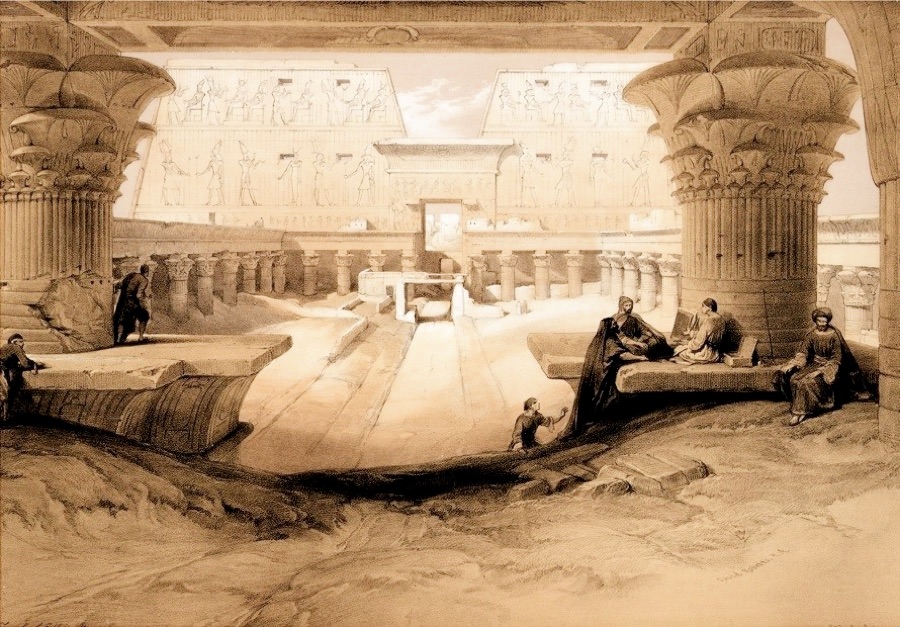VIEW FROM UNDER THE PORTICO OF THE TEMPLE OF EDFOU, UPPER EGYPT.
THIS view, taken from beneath the entrance of the portico, and looking across the grand peristyle court of the Temple to the back of the great propylon, is one of striking magnificence; it embraces the whole court; and the propylon, in noble proportion, seems to shut out the very sky towards the entrance. The cloistered corridor within the court, covered with painted hieroglyphics, offered its shelter from an Egyptian sun to the priests and those permitted to enter the sacred precincts. The propylon wants only its coved cornice to complete it. A bold torus forms an outline to these towers: between them, the entrance, with its beautiful cornice and enrichments of sculpture, offers one of the finest examples in Egypt of this peculiar architectural character. The vast faces of the towers are covered with gigantic figures, cut in bold intaglio-relievo, and represent the offerings made by the Pharaohs to the gods. The holes, which admitted light through the walls of these towers, served also to attach the staffs of the standards, from which, in days of ceremony,
the flags waved over the groups in procession.
The accumulations of sand within and about the Temple of Edfou, together with the vast heaps of corn kept here by the Government, in magazines divided by earthen walls, conceal the bases of columns round the court; and, within the pronaos, the sand has choked up all access to the sanctuary. Owing to the covering of the roof by the huts of the modern inhababitants, a small part only of the interior is accessible through a narrow aperture, and can only be examined with the aid of a light.
In the foreground, the large coved cornices of the jambs, without a lintel, of the entrance, are here seen in all their magnitude; the figures, with the rest or move upon them are proportionate, and have ample space, and the sand, rising to the level of the cornice, make their summits accessible. In comparison with these figures, how enormous are these capitals! and yet how beautiful their structure! this well deserves attention. Each reed which rises above the bands is surmounted with the lotus-flower, and each two supports one larger, which springs up between them; on each two, again of these, rests another flower, double the size of the former; above and between each of these rises a still larger lotus, until one more between each pair, still increasing in magnitude, completes this noble member of the column. Each, as it rises, spreads out, till the whole, in exquisitely proportioned composition, becomes the lotus capital of the Egyptian Temple, on which a small square abacus rests, and props the entablature. Still nearer, in this view, another variety of this capital appears: the pointed leaves of the plant spring from the reeds, and are surmounted by light flower-stalks, which alternate around the capital, in their terminations of a bud and a flower. The enormous stones, which rest upon and stretch from column to column, are among the wonders of Egyptian structure. On the front and back and on the soffit of these masses the winged globe and asps shed their influence over those who pass, and everywhere appear to guard or to warn the visitor.
Perhaps no point in this vast edifice is made more striking by contrast, than the grand propylon, with a few mud huts which rest against it on the cornices of the colonnade that surrounds the court; they have scarcely more importance in the scene than swallows’ nests under the gable of a modern dwelling.


